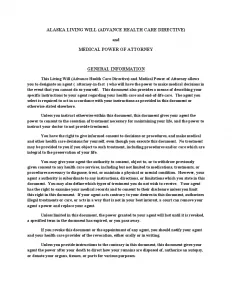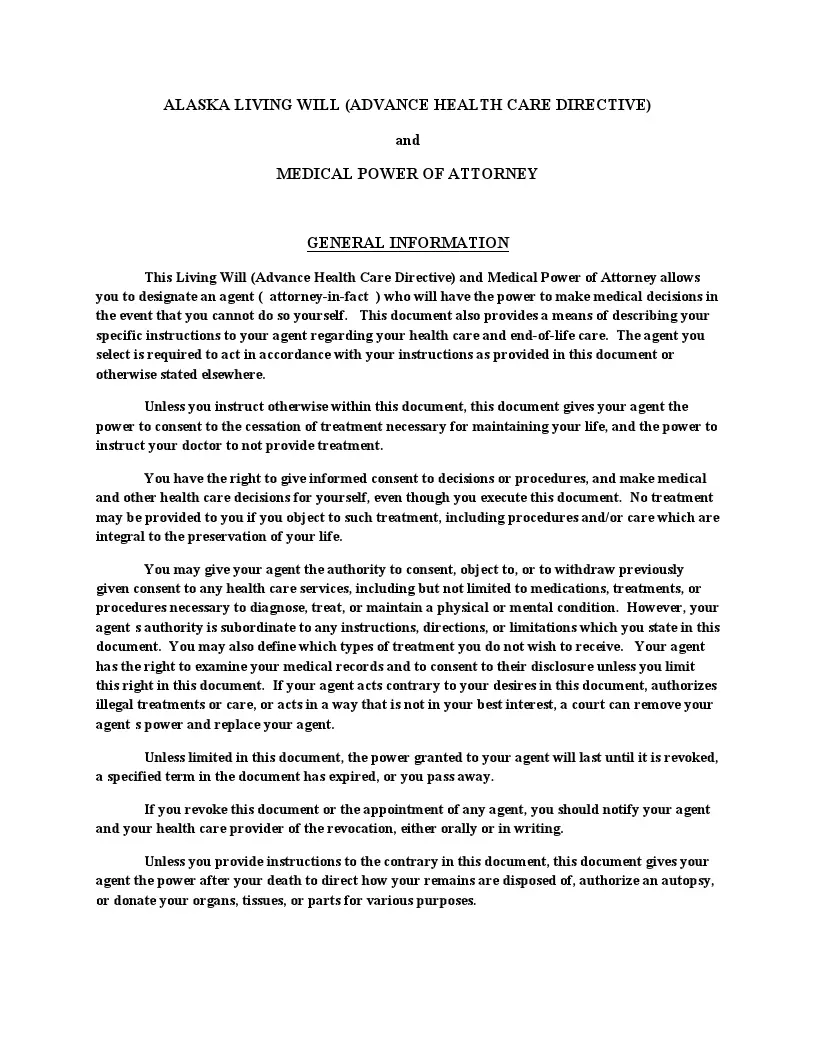Free Alaska Living Will Form
A living will in Alaska is a legal document that allows you to outline your preferences for medical treatment if you cannot make decisions for yourself. This is part of what is known as an advance directive. The primary purpose of a living will form is to provide instructions regarding life-sustaining treatments if you are terminally ill or in a persistent vegetative state.
You can specify whether you want treatments that prolong life, such as mechanical ventilation, feeding tubes, or resuscitation if you are in a condition with no expected recovery. You can also include desires for pain relief and other palliative care.
The Alaska living will form is accompanied by a durable power of attorney for health care. This document allows you to designate an agent to make health care decisions on your behalf if you are unable to do so.
Signing Requirements and Laws
Alaska Statutes Section 13.52.010 details the legal requirements for executing a living will. The living will must be signed by the declarant or another individual on the declarant’s behalf if the declarant is physically unable to sign it in the presence of two competent witnesses. These witnesses must be at least 18 years old. Witnesses to a living will in Alaska must not be:
- Related to the declarant by blood, marriage, or adoption.
- Entitled to any portion of the declarant’s estate under any will or by operation of law.
- Directly financially responsible for the declarant’s medical care.
- Beneficiaries of the declarant’s life insurance policy.
- Health care providers or employees of a health care provider treating the declarant.
According to Alaska Statutes Section 13.52.050, the declarant can revoke a living will at any time without regard to their mental or physical condition. The revocation can be done in any manner by which the declarant can communicate intent to revoke, whether by verbal statement, physical destruction of the document, or writing.
Once properly signed and witnessed, a living will becomes a legally binding document. Health care providers and facilities must follow the instructions in a living will as long as they have been informed of its existence and presented with it.
Alaska Living Will Form Details
| Document Name | Alaska Living Will Form |
| State Form Name | Alaska Advance Health Care Directive |
| Signing Requirements | Two Witnesses or Notary Public |
| Validity Requirements | Alaska Statutes Section 13.52.010 |
| Powers Limitation | Not specified in general statute; can be outlined in the document |
| State Laws: Alaska Statutes, Title 13, Chapter 52 | |

Steps to Fill Out the Form
Filling out the Alaska Advance Health Care Directive enables you to designate a person to make medical decisions on your behalf and to specify your health care preferences. Below, you’ll find the steps to fill out this form correctly.
1. Designation of Agent
Begin by appointing your primary health care agent. Enter the full name, address, and telephone number of the individual you trust to make health care decisions on your behalf. This person will act according to your wishes and in your best interest when you cannot make decisions yourself.
2. Alternate Agents
It’s wise to designate alternate agents if your primary agent is unable or unwilling to serve. Provide the names, addresses, and telephone contacts for your first and, if necessary, second alternate agents. This part ensures there is no gap in representation for your health care decisions.
3. Agent’s Authority
Specify the extent of the authority you grant to your agent. You can allow them full authority to handle all health care decisions or restrict their powers to certain decisions. Clearly outline any limitations in the space provided. This section ensures that your health care is managed as you wish.
4. Effective Date of Agent’s Authority
Indicate when your agent’s authority should commence. Typically, this authority becomes effective when a physician determines that you are unable to make your own health care decisions. However, you can allow it to take effect immediately by checking the appropriate box.
5. Agent’s Obligation
Clarify that your agent must act according to the instructions outlined in the directive and consider your best interests when making decisions. This part includes considering your values and the medical implications of treatments.
6. Nomination of Guardian
If a court needs to appoint a guardian for you, nominate your health care agent or one of your alternates for this role. This ensures that someone familiar with your preferences and who has your trust can oversee your well-being.
7. Health Care Instructions
Detail your wishes regarding various health care treatments, including end-of-life decisions and pain management. This section is crucial for directing your care according to your values and can include directives about artificial nutrition, resuscitation, and other treatments.
8. Anatomical Gift At Death
If you wish to make an anatomical gift after death, specify the organs and tissues you want to donate. You can choose to donate any needed organs or specify particular ones for donation purposes like transplant, research, or education.
9. Mental Health Treatment Decisions
If applicable, outline your preferences for mental health treatments, including psychotropic medications and electroconvulsive therapy. This section is only followed if you cannot make these decisions yourself.
10. Primary Physician
Designate a primary physician with the principal responsibility for your health care. Provide their name, address, and telephone number. You can also appoint a secondary physician if the primary is unavailable.
11. Signature and Witnessing
After completing the form, sign and date it in the presence of two qualified witnesses or a notary public. The witnesses must meet specific requirements, such as not being related to you or financially interested in your estate. This legal witnessing ensures that your directive is recognized and enforceable.

Below are various other Alaska templates completed by our users. Try our simple builder to customize these forms to your preferences.
